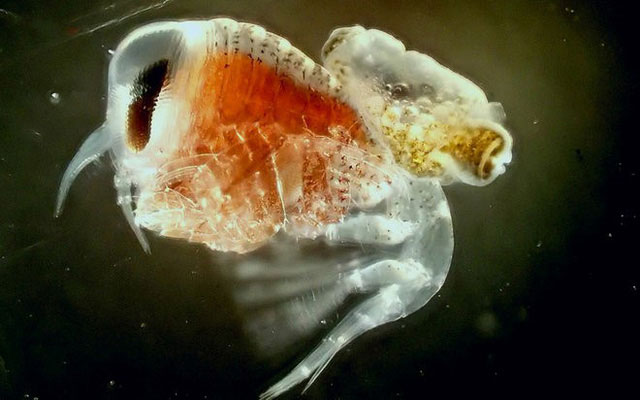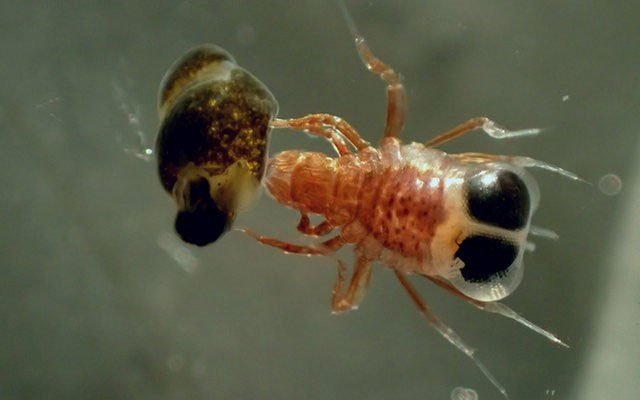Antarctic crustaceans know 'kidnapping' for self-defense
Pteropod - a pea-sized marine snail, protects its transparent and fragile body from predators with a strong chemical compound . However, there is another creature - immune to poison from the sea slug - that is taking advantage of this tiny snail's characteristic weapon.
In the southern sea, near Antarctica, amphipod - a set of small arthropods without apricot, shaped like a shrimp - looking for sea snails to mechanically automate the chemical. When exposed, the amphipod "kidnaps" the sea slug and 'wears' them like backpacks behind them , holding the object tightly with two pairs of legs, so the snail cannot escape.

On contact, amphipod "kidnap" the sea slug and "wear" them like backpacks behind their backs.(Photo: Charlotte Havermans / Alfred Wegener - Institute of Marine and Polar Research).
Fish and other predators when attacking the amphipod will have to receive the toxin secreted by the sea slug, so later they will ignore the ' snapped ' amphipods on their backs, scientists announced in a study. new. While this interaction is very effective with amphipod, the victim does not benefit from it. In fact, the researchers found that nudibranchs could not feed themselves when they became 'backpacks' , so 'snatched' snails would often starve.
Research nearly three decades ago described the phenomenon of amphipod 'wearing backpacks' in coastal waters near Antarctica; At that time, this 'kidnapping' strategy appeared to counteract - quite effectively - ice fish species that preyed on sight. But scientists cannot determine the prevalence of this behavior in southern ecosystems or interactions between marine organisms, the new study says.

An amphipod is carrying the 'kidnapped' object.(Photo: Charlotte Havermans / Alfred Wegener - Institute of Marine and Polar Research).
Scientists collected samples at four locations in the freezing sea from Antarctica to the Indonesian Sea, and found the characteristics of two species of amphipods: the Hyperiella dilatata species only 'snatched' the snails of Clione limacina antarctica , and species. Hyperiella antarctica only 'abducted' snail Spongiobranchaea australis .
Both male and female amphipods have this behavior, the size of the victim varies from one fifth to half the length of the host body. And this attachment is maintained even when the amphipod is dead, the researchers said.
In 342 collected amphipod samples, only four individuals 'wear backpacks'. Few specimens have made it impossible to ascertain that the amphipod intentionally targets a sea slug, or will catch any kind of sea snail that has toxins to carry with you, the study concluded.

Hyperiella dilatata bears a yellow snail Clione limacina antarctica behind.(Photo: Charlotte Havermans / Alfred Wegener - Marine and Polar Research Institute).
The interaction between small marine organisms such as this is particularly difficult to observe and study, because their fragile bodies are often damaged by the sample collection system, Charlotte Havermans - chair of the study. - Biologist of the Natural Environment Bureau at the Royal Belgian Academy of Sciences said. But new technological advances in digital cameras can soon see "even the smallest forms of life in water , " Havermans said.
- The principle that every adult must know to prevent kidnapping children
- Hard to believe but true: Ants specialize in 'kidnapping children' to survive
- The 'survival' rule must teach your baby to avoid kidnapping
- Crustaceans are poisonous
- Discover new crustaceans off Spain
- The most mysterious kidnappings of UFOs ever recorded
- Armrests against kidnapping
- There are still many deep-sea creatures that we don't know yet
- 'Treasure of the creature' under the Antarctic sea
- Detecting the adaptive mechanism of crustaceans when hypoxic
- Video: US missile defense system shows China must be
- Find the answer to Antarctic paradox
 Surprised: Fish that live in the dark ocean still see colors
Surprised: Fish that live in the dark ocean still see colors Japan suddenly caught the creature that caused the earthquake in the legend
Japan suddenly caught the creature that caused the earthquake in the legend A series of gray whale carcasses washed ashore on California's coast
A series of gray whale carcasses washed ashore on California's coast Compare the size of shark species in the world
Compare the size of shark species in the world